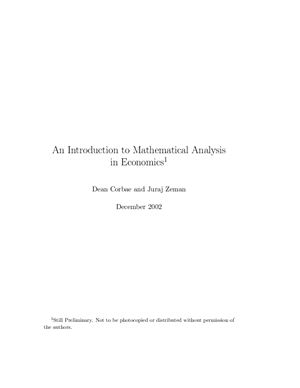2002. - 306 pages.
The objective of this book is to provide a simple introduction to mathematical analysis with applications in economics. There is increasing use of real and functional analysis in economics, but few books cover that material at an elementary level. Our rationale for writing this book is to bridge the gap between basic mathematical economics books (which deal with introductory calculus and linear algebra) and advanced economics books such as Stokey and Lucas' Recursive Methods in Economic Dynamics that presume a working knowledge of functional analysis. The major innovations in this book relative to classic mathematics books in this area (such as Royden's Real
Analysis or Munkres' Topology) are that we provide: (i) extensive simple examples (we believe strongly that examples provide the intuition necessary to grasp difficult ideas); (ii) sketches of complicated proofs (followed by the complete proof at the end of the book); and (iii) only material that is relevant to economists (which means we drop some material and add other topics (e.g. we focus extensively on set valued mappings instead of just point valued ones)). It is important to emphasize that while we aim to make this material as accessible as possible, we have not excluded demanding mathematical concepts used by economists and that the book is self-contained (i.e.
virtually any theorem used in proving a given result is itself proven in our book).
The objective of this book is to provide a simple introduction to mathematical analysis with applications in economics. There is increasing use of real and functional analysis in economics, but few books cover that material at an elementary level. Our rationale for writing this book is to bridge the gap between basic mathematical economics books (which deal with introductory calculus and linear algebra) and advanced economics books such as Stokey and Lucas' Recursive Methods in Economic Dynamics that presume a working knowledge of functional analysis. The major innovations in this book relative to classic mathematics books in this area (such as Royden's Real
Analysis or Munkres' Topology) are that we provide: (i) extensive simple examples (we believe strongly that examples provide the intuition necessary to grasp difficult ideas); (ii) sketches of complicated proofs (followed by the complete proof at the end of the book); and (iii) only material that is relevant to economists (which means we drop some material and add other topics (e.g. we focus extensively on set valued mappings instead of just point valued ones)). It is important to emphasize that while we aim to make this material as accessible as possible, we have not excluded demanding mathematical concepts used by economists and that the book is self-contained (i.e.
virtually any theorem used in proving a given result is itself proven in our book).

